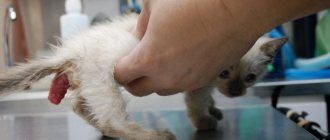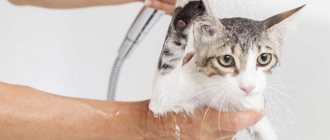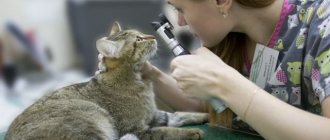When talking about common feline diseases, one cannot fail to mention cancer. Yes, unfortunately, animals, like people, have a fairly high risk of developing cancer. A tumor of the mammary gland in cats is quite common, and in four out of five cases the disease takes a malignant course. This serious illness can be completely cured only with early diagnosis. The owner should closely monitor the health of his pet and, if a small lump or lump appears in the mammary glands, be sure to contact a veterinary clinic for advice.
Causes
Today, only a number of factors are known, the presence of which leads to the development of mammary gland cancer in cats. And the exact causes of this dangerous disease are still unknown to medicine. The hormonal factor is of greatest importance. Fluctuations in hormonal levels in an animal’s body can be caused by various reasons:
- Natural fluctuations. They accompany estrous cycles (physiological changes in the body that occur during the period between two estrus cycles). In this case, the risk of cancer is reduced by early (before the first heat) sterilization of the cat.
- Artificially created vibrations. This includes the effect on the hormonal background of the animal’s body with drugs of the hormone progesterone, which is prescribed to reduce the level of aggression in cats or to prevent unwanted pregnancy in females. In this case, you can avoid the risk of oncology by refusing to prescribe such drugs (or giving them not regularly, but occasionally).
In addition, the following factors increase the likelihood of tumor processes in the mammary gland:
- Age of the cat. The disease usually does not affect kittens. Cats aged 10 years and older are most susceptible to the disease.
- There is a breed predisposition. It is believed that tumors appear more often in cats of Oriental and Siamese breeds.
- Hereditary predisposition also matters.
- The risk increases if the cat has lived for a long time in a polluted environment.
- Feeding low-quality feed, a poor, monotonous diet significantly reduces the animal’s body’s resistance, and therefore increases the risk of getting sick.
There is also a version that cancer of any location, including a breast tumor, has a viral etiology. But definitive proof of it still does not exist.
Stages of the disease
Mammary cancer that occurs in a cat has four stages of development. They are recognized by their clinical signs and have different courses:
- The first stage is characterized by small, painless lumps. The lymph nodes are not yet enlarged. The disease detected at this stage can be completely cured, and the cat continues to live.
- The second stage is characterized by a more dense neoplasm, which can reach a diameter of three centimeters. The tumor at this stage is operable, animals have an approximately one-year survival rate.
- The third stage is a tumor larger than three centimeters in size, inflamed lymph nodes. The cat protects the chest, experiencing pain in the affected area.
- The fourth and final stage cannot be cured. The neoplasm is significant in size. Lymph nodes are greatly enlarged. The cat is exhausted. There are already metastases. In most cases, at this stage of the disease, surgery is powerless. Severe pain is relieved by constant use of painkillers. The prognosis of the disease is unfavorable. In especially severe cases, animal euthanasia is used.
The degree of disease in the clinic is determined by the so-called staging system, which takes into account the size of the tumor and the results of aspiration biopsy of the lymph nodes. In addition, to determine the number and localization of metastases, radiography in three projections, ultrasound examination of the abdominal cavity, computed tomography and magnetic resonance imaging are prescribed.
Types of breast tumors
Most tumors (and there are 4 pairs in total) develop from glandular epithelium and are divided into three large groups:
- Adenoma and fibroadenoma (in the case of a benign course), it is quite rare.
- Carcinoma or adenocarcinoma (in the case of a malignant course) of the mammary gland in a cat, it is much more common. Most of it comes from the epithelium of the ducts and alveoli of the mammary glands. Inflammatory carcinoma of the mammary glands is especially dangerous. It is accompanied by an inflammatory process and therefore has a particularly unfavorable prognosis.
- Mixed tumors affect both ductal and epithelial tissues of the mammary glands. They are characterized by a more favorable course.
Breast carcinoma is a mobile nodular formation. In later stages, it often breaks open and may ulcerate or bleed. The mammary glands are most often affected on one side, less often on both sides. The disease is accompanied by enlarged lymph nodes, especially in the groin and axillary areas.
It is not always possible to determine the type of tumor (benign or malignant), especially if it has burst. In this case, the treatment regimen is based on the method of treating a potentially malignant neoplasm.
Treatment of cancer in pets
Depending on the clinical picture and stage of the pathological process, treatment of cancer in cats is carried out in 3 ways :
- Surgical removal of the tumor. This is the most effective method, but it is used only in the absence of metastases. During the operation, a malignant tumor is excised under general anesthesia, after which the four-legged patient is given chemotherapy to destroy the remaining cancer cells.
Linear accelerator for radiotherapy
- Radiation therapy. This method involves exposing the affected area to ionizing radiation. The manipulation is carried out under general anesthesia by remote (when irradiation occurs at a distance from the four-legged pet) or by contact, in which the radiation source is introduced into the formation itself or the cavity in which it is located.
- Chemotherapy. This procedure is often combined with surgical excision of the affected tissue. It involves intravenous infusion of toxic solutions that have a detrimental effect on cancer cells. This manipulation is carried out several times according to a certain pattern. As a rule, drugs such as Vincristine, Cisplatin, Cyclophosphamide, etc. are used for treatment. Chemotherapy causes hair loss, nausea, apathy, and poor digestion of food.
Characteristic symptoms
The main symptoms appear when the disease has already entered the advanced stage. At this stage, the animal’s general well-being worsens and its appearance changes. The tumor may appear as single or multiple nodes. The inguinal and axillary lymph nodes are inflamed. The lesion may involve several lobes of the mammary gland. Sometimes its true size can only be assessed after shaving the fur over a fairly large area of the body. The main clinical signs at this stage are:
- the neoplasm is significant in size;
- there is quite severe inflammation of the surrounding tissues;
- the cat is in quite a lot of pain;
- body temperature may rise;
- the animal loses weight sharply, there is no appetite;
- Bleeding and discharge of pus from the opened tumor are possible.
If a cat's mammary gland is swollen and painful, this is not always associated with cancer. Very often, some non-tumor conditions of the mammary glands have similar signs. Basically, these are hyperplasias (tissue growths) of various etiologies and some other conditions:
- hyperplasia of the gland ducts;
- breast cysts;
- lobular hyperplasia;
- fibroadenomatous hyperplasia;
- false pregnancy;
- true pregnancy;
- consequences of the administration of progesterone hormone drugs.
Mastitis
It is a consequence of early weaning from a nursing mother, sometimes - diseases of the genital organs, damage to the nipples or false pregnancy.
The mammary glands become inflamed and swollen, become hard and hot, and the body temperature rises. This is what a Sphynx cat looks like:
If a nursing female is sick, milk may not be released or will come along with pus. The doctor, after the necessary tests, will make sure that there is no cancer and will prescribe treatment.
If the illness is mild, he will prescribe compresses and massages at home; if it is severe, he will prescribe medications, including antibiotics, or even surgery.
Establishing diagnosis
As already mentioned, with breast cancer, early diagnosis of the disease is very important, so the owner is required to deliver the animal to a good veterinary facility on time. Only a doctor can make a high-quality diagnosis. He has at his disposal all types of instrumental examinations (ultrasound, radiography, magnetic resonance and computed tomography). In addition, a biopsy or fine needle aspiration (penetration) of the lesion for cytological examination helps to make an accurate diagnosis.
A lot depends on how carefully the biopsy material is taken. Additional trauma to the tumor can lead to a sharp increase in the number of metastases, which will make the patient's condition more severe. The inguinal and axillary lymph nodes must be examined, since they are also often affected by the disease.
In this case, a detailed blood test, including its biochemical formula, is no less informative. It will allow you to determine the degree of the inflammatory process, as well as the presence of concomitant infections, which cannot be ignored when prescribing a treatment regimen.
Complication after sterilization
A lump appears when sutures are placed incorrectly, threads are quickly absorbed, or mechanical damage occurs. The danger lies in infection through the resulting holes, so if they are detected, an urgent visit to the veterinarian is necessary.
A lump on a cat’s stomach appears for a variety of reasons, for example after an injection. The most dangerous are cancerous tumors, the treatment of which depends on timely detection. In any case, the emerging neoplasm requires diagnosis and therapy, as it easily develops into severe forms with complications.
Treatment methods
In most cases, treatment for breast cancer is radical. Surgery to remove the tumor is proposed. It usually takes place in several stages:
- removal of a mammary tumor, which is performed in cats with a significant area of healthy tissue;
- removal of nearby lymph nodes to prevent further metastasis;
- chemotherapy - as the final stage of treatment, designed to stop the tumor process and eliminate the possibility of relapses.
Removal of the affected area with a significant area of healthy tissue
The smaller the tumor size, the higher the chances of success of the operation. It is believed that the prognosis of the disease is favorable if the diameter does not exceed 3 cm. The degree of surgical intervention may vary depending on the size of the affected area:
- If the cat's tumor is small in size, only the affected gland is removed.
- If neighboring glands are captured, then during one intervention the entire row of glands is removed.
- If it is bilateral (two-sided), removal of the breast tumor is carried out in two stages with an interval of two weeks. But, if the lower or upper layers of the skin are involved in the tumor process, the entire affected area is removed at once.
It is difficult to say how long a cat will live after a mastectomy. The operation is classified as difficult, so a 100% guarantee of success is usually not given. There is also no certainty that the disease will not return in the form of a relapse.
Removal of lymph nodes
Fine-needle aspiration of regional (associated with the organs in question) lymph nodes makes it possible to determine the degree of their involvement in the pathological process. Usually, surgery is prescribed to remove the affected lymph nodes (inguinal and axillary). Sometimes ovariohysterectomy (removal of the uterus and ovaries) is performed simultaneously, which facilitates postoperative therapy.
Chemotherapy
Chemotherapy is the final stage of treatment. During it, quite strong drugs are used (Doxorubicin, Cyclophosphamide), which help to completely stop the tumor process. But, at the same time, they have quite significant side effects and cause severe intoxication of the body. Therefore, chemotherapy is carried out under careful monitoring of the animal’s condition.
If a cat has contraindications to mastectomy (old age or poor health), chemotherapy becomes the only way to stop the pathological process and even slightly reduce the size of the tumor.
Chemotherapy is also used when the tumor is small and the attending physician decides to do without surgery.
Help with tumor diseases
If your pet has a mammary tumor and purulent discharge is observed, consultation with a veterinarian is necessary. In most cases, the exposed tumor is urgently removed. But, if this path is dangerous, they resort to conservative treatment. Applications of Levomekol ointment are usually prescribed. Before smearing, treat the wound with chlorhexidine. In addition, antibiotic therapy is carried out (Tsiprovet, Fosprenil). The wound is covered with a loose bandage, with free access of air. A loose blanket is put on top.
If a cat has a tumor, it needs to be given maximum attention and care. You can take care of her without fear for your health - the disease is not contagious.
A cat is bleeding from the mouth - possible causes
One of the most dangerous signs that a cat owner may notice in cats is the appearance of blood from the mouth or bloody vomiting. Hematemesis (the scientific name for bloody vomiting) is a sign of serious damage to internal organs.
By the color of the expelled contents, you can approximately determine the location of the lesion. So, if scarlet blood is present in the vomit, this indicates damage to the upper part of the digestive system - the oral cavity, esophagus or pharynx.
The appearance of vomit the color of coffee or coffee grounds indicates bleeding in the mucous layers of the stomach or the upper parts of the small intestine.
First of all, the owner needs to inspect the animal’s oral cavity for damage that could cause bleeding. You need to pay attention to the condition of the gums and teeth, the presence of damage to the mouth, the amount and color of blood, and the presence of a suspicious odor.
The general condition of the animal is also important - appetite, activity, thirst. In any case, it is necessary to contact a veterinarian as soon as blood appears from the cat’s mouth. This will allow for timely diagnosis and provision of emergency care to the animal in case of serious threats to life.
Causes of bleeding in cats
There are many reasons why a cat may bleed from the mouth. It is almost impossible to make an accurate diagnosis based on clinical examination alone.
There are several underlying factors that can cause bleeding from a pet's mouth. The main ones are:
- damage to the integrity of the oral mucosa;
- damage to pulmonary structures;
- poisoning with toxic substances;
- damage to liver structures;
- bleeding in the stomach.
Damage to the oral mucosa occurs quite often in cats as a result of increased activity of the animal and as a result of fights with competitors. Small kittens can injure their oral cavity with foreign objects, since in the process of learning about the world they often try everything.
Bleeding from the mouth when the gums, palate or tongue are damaged, is accompanied by small discharges of a red or pinkish tint. For minor injuries, the blood stops flowing on its own after 5-10 minutes. In case of more serious damage to the oral mucosa, bleeding may take longer.
It is worth paying attention to the nature of the leakage - if the blood flows jerkily, then this indicates damage to a large capillary in the head area and can have serious consequences if assistance is not provided in a timely manner.
The appearance of bloody vomiting in a cat with foam may indicate damage to the pulmonary structures. With pulmonary hemorrhages, the amount of blood flowing out is small, and the clotting process is practically absent.
If you find your pet vomiting pink foam, you need to show the animal to a veterinarian as soon as possible. Any delay can cost your pet's life.
Poisoning with toxic substances.
Cats are often poisoned with poisons intended to kill rodents. All poisons aimed at controlling rodents have the property of inhibiting enzymes responsible for blood clotting factors.
With an acute shortage of blood clotting factors, the cat experiences internal bleeding. And one of the symptoms of acute zoocoumarin poisoning is when a cat vomits blood.
A pet can be poisoned not only by rat poison, but also by household chemicals, as evidenced by vomiting brown blood, which is associated with damage to the mucous membranes lining the stomach.
Liver diseases and problems associated with blood clotting disorders
lead to damage to all internal organs and systems. If an animal begins to vomit and there is blood in the vomit, this may indicate the onset of destructive processes in the liver or hematopoietic system.
The appearance of vomiting with blood is also observed during exacerbation of chronic diseases
non-contagious etiology. It is noted that such vomit does not have a foamy structure.
Damage to the gastric mucosa
leads to bleeding from the cat's mouth. More often, a violation of the integrity of the walls of the stomach is accompanied by vomiting and eruption of gastric contents. The pet refuses food and sometimes water. The released blood acquires a characteristic brown color and a repulsive odor.
The main cause of damage to the walls of the stomach is foreign objects and malignant neoplasms in the digestive system, as well as ulcers.
Vomiting of blood during tumor processes is observed, as a rule, already in the last stages, when the diagnosis is already known earlier. Gastric ulcers are not uncommon for cats, but timely diagnosis and correct treatment tactics can prolong the animal’s life, preserving its functionality and eliminating discomfort.
Diagnosis and treatment of bloody discharge from the mouth of a cat
When the owner notices that the cat is vomiting and there is blood in the vomit, it is necessary to immediately contact a veterinarian. There are a number of measures that the owner can provide independently at home to alleviate the animal's condition.
First of all, you need to put your pet on a fasting diet for at least 12 hours. Otherwise, the passage of food through the digestive tract can cause additional damage to the mucous membrane, and the body will spend additional energy on recovery. You can give your pet a warm decoction of chamomile.
The animal is unlikely to drink such a healing infusion on its own, so the cat will need to be fed in small portions. Even if the animal’s condition has stabilized, you should not postpone a visit to the veterinarian.
In a veterinary hospital, before taking treatment measures, it is necessary to undergo all studies and tests. The doctor must conduct a clinical examination of the sick pet and also collect an anamnesis.
Auxiliary diagnostic measures are:
- blood chemistry;
- analysis for viral infection;
- stool analysis.
Depending on the clinical picture of manifestations, the range of diagnostic measures can be expanded. Thus, if a foreign object is suspected of entering the digestive tract or a malignant tumor, an ultrasound examination or computed tomography is recommended.
Often, an X-ray examination is necessary to make an accurate diagnosis. Based on a comprehensive study, the veterinarian selects an individual treatment regimen for each animal, taking into account the age, body weight and health status of the patient.
If the cause of your cat's nausea and vomiting of blood is chemical poisoning, treatment should first include administering an antidote. In case of poisoning with rat poisons, gastric lavage is performed and vomiting is induced in a hospital hospital setting.
Next, treatment is carried out by introducing special medications that neutralize toxic substances in the body and also promote their rapid elimination.
When poisoned by rat poisons, the cat is given shock doses of vitamin K, which helps stop bleeding and normalizes blood clotting factors. Normalization of water and electrolyte balance is carried out by infusion of Ringer-Locke and glucose solutions through a dropper. Enterosorbents and enveloping agents are also indicated.
In special cases, in case of severe poisoning, blood transfusions are performed on the animal, but unfortunately, not all veterinary clinics can afford this procedure.
If the cause of bloody vomiting is damage to the mucous membrane of the stomach walls as a result of ulcerative lesions, therapy is aimed at eliminating the inflammatory process by administering special drugs.
An important point in the treatment of stomach ulcers is special dietary nutrition.
The entry of foreign objects into the esophagus, stomach or intestines, causing bloody vomiting, can only be treated surgically. During surgery, the affected part of the digestive tract is excised, tissue is sutured, and postoperative care and medications are prescribed.
In case of liver dysfunction, hepatoprotectors and drugs that relieve inflammation are prescribed. It is also necessary to constantly monitor the animal’s condition and prescribe a gentle diet. Most often, an animal with pathological changes in the liver structures is forced to be treated for the rest of its life.
Less dangerous pathologies accompanied by bleeding from the oral cavity in cats are damage to the mucous membrane of the mouth. But if treatment is not timely, the situation may worsen and then the treatment of the animal will be longer.
Severe bleeding from the mouth caused by a rupture of a large vessel requires immediate medical intervention. The blood must be stopped by applying cold (to narrow the lumen of blood vessels), as well as by administering vitamin K. It is also necessary to administer antibacterial drugs to prevent the development of pathogenic microflora in the animal’s oral cavity.
Prevention
It is not possible to protect your pet from all diseases. But it is possible to minimize the risks of developing a dangerous symptom.
To do this, it is important to regularly inspect the cat’s mouth for damage to the teeth and mucous membranes, and to monitor the little kitten so that it does not pick up various objects and play with them.
Even adult cats can swallow a needle or small ball, which can subsequently injure the digestive tract and cause bloody vomiting.
Do not forget about regular preventive examinations of the animal once every six months. This will allow timely diagnosis of diseases of internal organs and take measures to eliminate the pathology.
It is worth taking care of proper, balanced nutrition. Attentive attention to your pet’s condition will make it possible to promptly see changes in its behavior.
Source: https://zen.yandex.ru/media/ivethelp/u-koshki-krov-izo-rta-vozmojnye-prichiny-5d20770aecbe4e00ad59b04b
Postoperative period: animal care
A caring owner should know what to do in the postoperative period. His main task is to accurately follow all medical recommendations:
- The most important condition is to create all the conditions for the animal to recover as quickly as possible. He needs rest for successful rehabilitation.
- The diet is compiled together with the attending physician. Only recommended foods or feeds are allowed and given in moderation. There should be no deviations from the dietary regime.
- Timely treatment of seams and surrounding tissues is important.
- Postoperative drug therapy will help create protection against infections to eliminate the possibility of complications.
- Protective bandages and blankets should be used to prevent the animal from injuring the operated area.
At the slightest hint of postoperative complications (the stitches have ruptured and pus appears, or the temperature has risen), you must immediately take the animal to the clinic.
Preventive measures
A preventive measure that provides almost one hundred percent protection against this disease is sterilization of the cat in childhood, even before the onset of the first heat, and castration of the cat before the age of 1 year.
Regular prevention consists of the following:
- when playing with a cat or male cat, it is necessary to conduct an incidental examination of the mammary glands;
- the animal is subjected to an annual preventive examination at a veterinary institution after reaching 10 years of age;
- hormonal medications that regulate the cat’s sexual activity and delay the onset of pregnancy should be abandoned;
- It is equally important to follow the principles of proper and nutritious nutrition for your pet;
- and, finally, it is necessary to promptly treat inflammatory diseases of the genitourinary system of pets.
Breast tumors are a very serious disease. Any person caring for their pet is interested in the question: how long do cats with this disease live? If detected early, their lifespan may not be limited by the disease. In other cases, their average lifespan ranges from 2 to 20 months (if you count from detection).
You should never despair and lose hope for the recovery of your family friend. We must do everything possible and believe, according to the principle: as long as you believe, you live.










